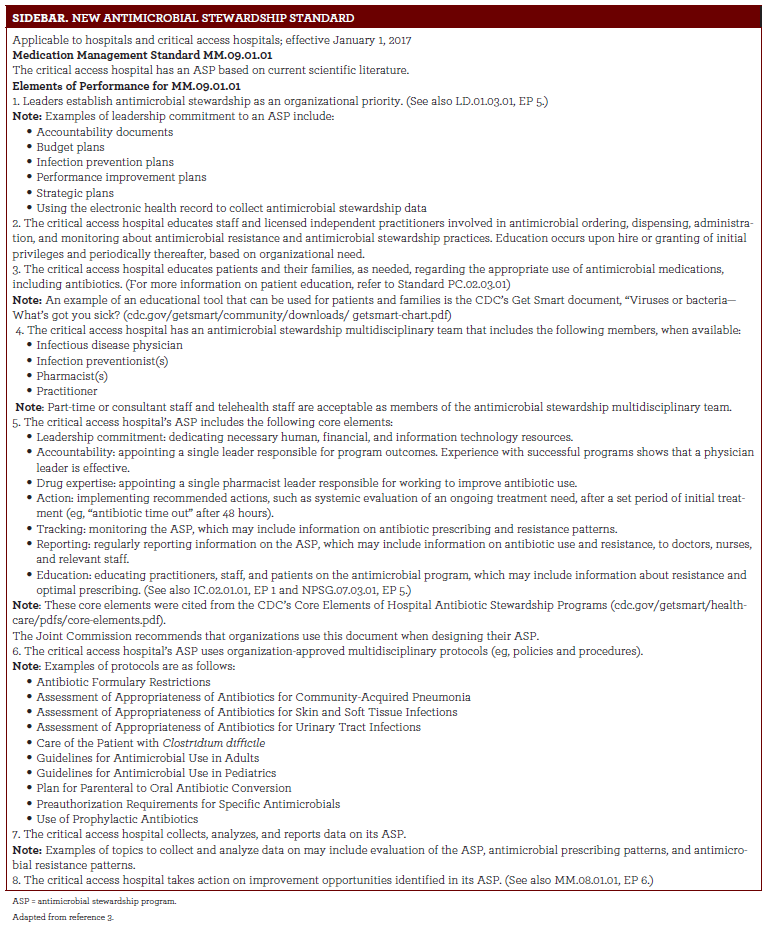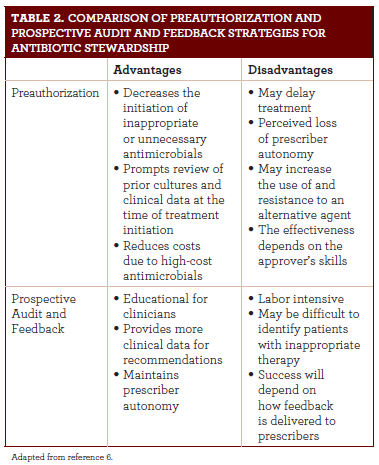Antimicrobial Stewardship Standard: Time for Change
According to the CDC, antibiotics prescribed in US acute care hospitals are unnecessary or inappropriate 20% to 50% of the time.
Evidence of Concern
According to the CDC, antibiotics prescribed in US acute care hospitals are unnecessary or inappropriate 20% to 50% of the time.1 This inappropriate prescribing can result in preventable allergic reactions, adverse drug reactions, and Clostridium difficile infections.1,2 Approximately 250,000 of these infections and 14,000 deaths from them occur on an annual basis in patients hospitalized as a result.2 Inappropriate prescribing can also cause resistant infections. The CDC estimates that more than 2 million Americans are infected with antibiotic-resistant bacteria each year, which leads to approximately 23,000 deaths annually.1
The importance of antibiotic use is not new. Before the recommendation was issued for all acute care hospitals to implement an antimicrobial stewardship program (ASP) and before the new Antimicrobial Stewardship Standard was issued by the Joint Commission, many important developments had already occurred over the years. For a timeline of events, see Table 11,3,5.

Summary of New Antimicrobial Stewardship Standard
The Joint Commission’s new medication management standard (MM.09.01.01) that addresses antimicrobial stewardship became effective January 1, 2017. This standard includes 8 elements of performance—one of which requires a multidisciplinary team comprising an infectious disease physician, infection preventionist(s), pharmacist(s), and a practitioner (Sidebar3)—and the core elements that are highlighted in the CDC’s Core Elements of Hospital Antibiotic Stewardship Programs: leadership commitment, accountability, drug expertise, action, tracking, reporting, and education.1,3 It also requires multidisciplinary protocols that have been approved by the Joint Commission.3 For examples of protocols, see Sidebar.

In addition to the CDC’s core elements, the need for a multidisciplinary team, and protocols, the standard requires that organizations do the following3,4:
- Demonstrate leadership’s commitment to the program
- Educate licensed independent practitioners and staff members on antimicrobial stewardship practices and antimicrobial resistance
- Educate patients and their families on the appropriate use of antimicrobial medications (if additional information is needed to educate patients, refer to Standard PC.02.03.01)
- Collect, analyze, and report data on the organization’s ASP (eg, an organization may gather information on how the program is doing and identify and evaluate prescribing patterns and resistance patterns)
- Act on improvement opportunities that have been identified in the ASP
New Guidelines
The Infectious Diseases Society of America and Society for Healthcare Epidemiology of America published new guidelines in the journal, Clinical Infectious Diseases, in which they offer practical advice for implementation rather than cost savings. These new guidelines replace the original ones that were created to help institutions develop a program when antibiotic stewardship was a new idea. They focus on implementing specific strategies that have been proven to be the most beneficial in ensuring that the program is effective and sustainable.5
New Guidelines at a Glance5,6
Preauthorization and prospective audit and feedback should form the foundation of an ASP. The expert panel behind the guidelines included the following elements to ensure the development and implementation of an effective program:
- Preauthorization or prospective audit and feedback (strong recommendation, moderate-quality evidence) (Table 26)
- Syndrome-specific interventions (weak recommendation, low-quality evidence)
- Rapid diagnostic testing: Respiratory specimens (weak recommendation, low-quality evidence) Blood cultures (weak recommendation, moderate-quality evidence)
- Decreased use of antibiotics that have a high risk of C difficile infections (strong recommendation, moderate-quality evidence)
- Antibiotic time-outs or other strategies to encourage providers to review antibiotic regimens routinely (weak recommendation, low-quality evidence)
- Incorporation of computerized clinical decision support systems, at the time of prescribing, that are integrated into the electronic health record to improve antibiotic prescribing (weak recommendation, moderate-quality evidence)
The expert panel also stressed the importance that an ASP tailor interventions based on specific problems identified by the institution, expertise, and realistic evaluations of available resources. The guidelines recommend that physicians and pharmacists lead the ASPs, yet rely on infectious diseases specialists for their expertise.5

On another note, the new guidelines do not recommend that a program rely solely on passive educational materials because improvements are not sustainable this way. Educational materials, such as brochures and lectures, can be used to supplement strategies, noted the panel.5 The guidelines point out that additional research is warranted in order to determine how to verify an ASP can be most effective.5
Show Me the Money
Not only has the implementation of ASPs been proven to save lives through improving patient outcomes, decreasing antibiotic resistance, and decreasing C difficile infections, but the programs have demonstrated the ability to save health care a significant amount of money. Implementation of antibiotic stewardship inpatient programs within institutions and other health care facilities has led to cost savings between $200,000 to $400,000 in a given year7; one study demonstrated that an institution saved $17 million over 7 years. On the contrary, after the program was stopped, the same institution experienced an 32% increase in antibiotic costs, which amounted to more than $1 million in the first year—an amount that continued to increase in the following year.7
Anyssa Garza received her doctor of pharmacy degree from the University of Texas at Austin before becoming the director of pharmacy for a Central Texas Department of Aging and Disability facility. She now serves as the vice president of Content and Patient Education Programs at RxWiki. In this role, she provides patients with medication information and medical knowledge that will contribute significantly to the quality of care they receive and improve their quality of life and health outcomes. Her work focuses on educating patients and providing them with the resources they need to navigate the overwhelming and complex health system and their health care issues. She also is an adjunct assistant professor at the University of Texas at Austin College of Pharmacy.
References
- CDC. Core elements of hospital antibiotic stewardship programs. cdc.gov/getsmart/healthcare/implementation/core-elements.html. Accessed October 3, 2016.
- CDC. Vital signs: making health care safer. cdc.gov/vitalsigns/pdf/2014-03-vitalsigns.pdf. Accessed October 10, 2016.
- Joint Commission. New Antimicrobial Stewardship Standard. Joint Commission Perspectives. 2016; 36(7):1-8.
- New antimicrobial stewardship standard ashp.org/menu/News/PharmacyNews/NewsArticle.aspx?id=4346. Accessed December 15, 2016.
- Infectious Diseases Society of America (IDSA); The Society for Healthcare Epidemiology of America. New antibiotic Stewardship Guidelines Focus on Practical Advice for Implementation. IDSA website. idsociety.org/New_Antimicrobial_Stewardship_Guideline_2016/. Published April 14, 2014. Accessed October 7, 2016.
- Barlam TF, Cosgrove SE, Abbo LM, et al. Implementing an antibiotic stewardship program: guidelines by the Infectious Diseases Society of America and the Society for Healthcare Epidemiology of America. Clin Infect Dis. 2016;62(10):e51-77. doi: 10.1093/cid/ciw118.
- CDC. Get smart: save money with antibiotic stewardship. cdc.gov/getsmart/week/downloads/gsw-factsheet-cost.pdf. Accessed October 12, 2016.

